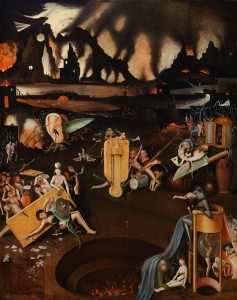The present work by an unknown follower of Hieronymus Bosch bears all the hallmarks of this celebrated artist, who died in 1516, 500 years ago. This depiction of hell repeats a number of details from Hieronymus Bosch’s right wing of the well-known triptych “The Garden of Earthly Delights” from around 1500 in the Prado Museum, Madrid.
The central motif of the “hurdy-gurdy” signifies one of the seven deadly sins: lust. This musical instrument alludes to the musicians who would travel from tavern to tavern and arouse sexual desire amongst the audience. In the Middle Ages, lust was described as “Music of the Flesh” and regarded as uncontrolled noise that was in contrast to the harmony that prevailed in heaven. To the right of the instrument one can discern a knight who seems to have committed a sacrilege; holding on to the Holy Grail, he is surrounded by wild dogs. Below, a bird-headed monster swallows the damned and excretes them into a transparent bubble above an opening right next to the furnace of hell. Vanity is embodied by a woman staring into a convex mirror that also forms the backside of a hellish demon. To the left of the musical instrument, a nude man, a symbol of humanity, is pinned to a tombstone. He is strangled by a creature on whose shield appears the hand of God. It points at a die that symbolises Man playing with the Word of God. Above, a pair of ears connected by an arrow holds a knife blade that morphs into a deadly erection suggestive of penetration and disruption.

Hell
oil on wood, 124 x 97.5 cm
price realised € 527.600
The present work bears testament to how man’s fear of a sinful life played a crucial role in 15th- and 16th-century Europe with regard to death and the afterlife.
For more information browse the online catalogue!













